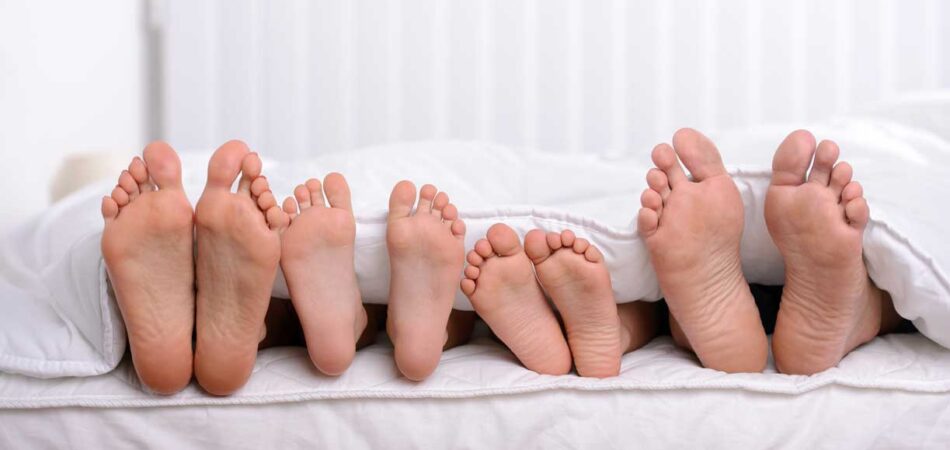
Foot pain can range from a minor annoyance to a debilitating condition, and it can be caused by a variety of factors.
In this article, we’ll delve into the potential causes of foot pain and provide tips for finding relief and preventing future discomfort.
Foot Pain Can Be Caused by Wearing the “Wrong” Shoes
The Healthy Aging organization estimates that 87 percent of people experience occasional foot pain. Sometimes, foot pain is almost expected.
When you are “breaking in” shoes that don’t fit properly, or you have been wearing high heels all day, foot pain is not a big surprise.
But there are also foot conditions that cause throbbing and pain even if your shoes fit perfectly or you don’t wear shoes at all.
Achilles Tendinitis
Ever come back from a hiking vacation with intense pain in your heel that seems to radiate up your calf?
Maybe with a limp when you are barefoot that goes away when you put your shoes on? Or heel pain with a foot that seems to flop along while you walk?
If these symptoms describe you, you could have Achilles tendonitis. There is a long list of common medical interventions for Achilles tendonitis. You probably have heard of RICE, rest, ice, compression, and elevation. Just sit around all day with an ice pack on your foot and the pain will go away!
Or more likely, you will have to wear orthotic shoes for a few weeks. But while you are recovering from Achilles tendonitis, keeping pressure off your feet at night also helps.
Bunions
Bunions, also known as hallux valgus, are a deformity of the front of the foot. It’s basically a bony bump that forms at the base of your big toe. It pulls the tip of your big toe over your other toes. This makes the joint behind your big toe jut out, so the skin over it gets sore.
Bunions become painful. As you might guess, they are a lot more common in people who wear high heels. Epidemiologists report that bunions are up to 15 times more common in women than in men, and they are most common in women who are at the peak of their professional careers, between the ages of 30 and 60. Keeping pressure off bunions makes them less painful.
Hammertoes
Hammertoes are toes that curl downward. They are caused by an imbalance in the tendons and ligaments that hold the toes in place. They usually occur in the second, third, or fourth toes, not the big toe or little toe. If you have hammertoes, you may need to wear inserts in your shoes to keep pressure off the tips of your toes. Your toes remain sensitive to pressure while you are sleeping.
Intermetatarsal Perineural Fibrosis
Intermetatarsal perineural fibrosis is a condition of swelling and inflammation in the tissues around the nerves that pass between the bones of your foot. It’s usually caused by constant irritation of your foot, and it can be relieved by reducing pressure on your feet at night.
Metatarsalgia
Metatarsalgia is a fancy term for pain in the lower foot. It’s common in soccer players and place kickers who put their feet through a lot of trauma. Relieving pressure on the foot relieves the pain.
We aren’t going to tell you that the solution for bunions, hammertoes, intermetatarsal perineural fibrosis, or metatarsalgia is to give up soccer or to wear flats to work. You may need medical intervention. See your doctor!
But there is something else you can do. Bunions, hammertoes, intermetatarsal perineural fibrosis, and metatarsalgia are all relieved by a product called Cozy Toezy It keeps your feet from getting tangled up in your sheets or weight down by your blanket or comforter at night. A Cozy Toezy may be exactly what you need to overcome chronic foot pain — along with properly fitting shoes!
But what if your feet hurt all the time and it’s not because you play soccer or wear high heels?
Chronic Conditions That Cause Chronic Foot Pain
Mature adults often develop chronic conditions that cause a variety of symptoms, including chronic foot pain. By age 65, about a third of people have one or more conditions that result in painful, throbbing feet. These conditions usually affect both feet.
Degenerative Arthritis
Over time, wear and tear on joints make them wear out. People who have osteoarthritis, also known as degenerative arthritis, will often have one or more joints in their feet that become “tight.” They lose their flexibility. The toes don’t point in quite the right direction, so there is constant skin irritation, too. Arthritis causes achy feet and, secondarily, inflamed skin.
Keeping pressure off arthritic feet doesn’t just reduce joint pain. It also reduces the risk of skin abrasions, which are particularly a problem in diabetic feet.
Insufficient Circulation
Many older people develop a condition called venous insufficiency. Basically, blood flows down to the feet through the arteries but it does not flow back up to the heart through the veins very efficiently. The feet become red and swollen, often painful. The skin becomes so dry that it cracks.
The right kind of pressure, compression socks, can make a huge difference in dealing with the symptoms of venous insufficiency. But compression socks don’t help at night (or generally when you are lying down). When you are sleeping, removing pressure on your feet makes sleeping easier and more comfortable.
Relieve Foot Pain with Cozy Toezy!
Everyone who has nighttime foot pain should follow their doctor’s advice. But there is one more thing you can do for quick, drug-free relief.
Make sure your sheets and blanket don’t weigh down on your feet.
Sure, we feel good almost all over when we snuggle up inside a weighted blanket.
But constant pressure on your feet can keep your nerves activated so they send you pain signals all night.
The way to keep your feet free so you can sleep well is the Cozy Toezy!


1 Trackback